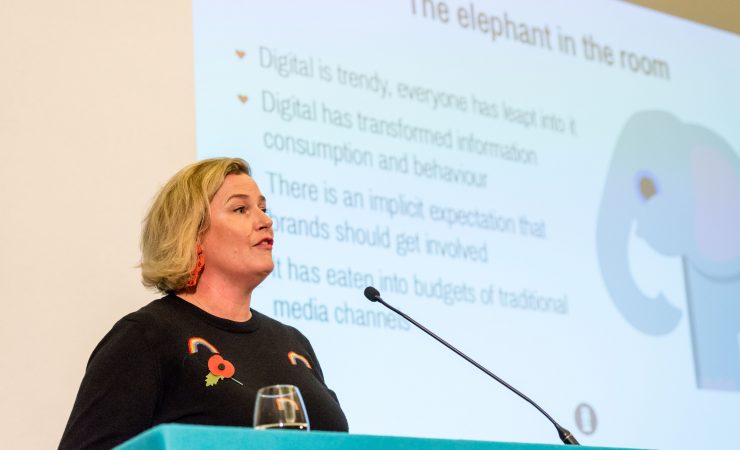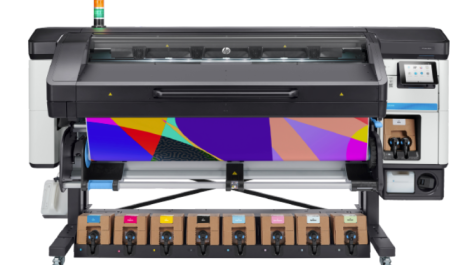There was a distinct sense at this year’s event that print is starting to regain lost ground as disillusionment with digital channels grows. Michael Walker reports.
Held in the historic surroundings of Stationers’ Hall in London, the eighth Power of Print conference was chaired for the morning session by BPIF CEO Charles Jarrold who used the organisation’s quarterly Printing Outlook report (see page 4) as the basis for his opening comments. While the picture varies widely across different media sectors, a decade of growth in advertising spend is still a positive, and around 40% of printers were seeing profit margins at or above 6%. Books and packaging are areas that are holding their own but Mr Jarrold acknowledged that volume commercial print is still in decline, saying that the focus must now be on ‘adding value beyond ink on paper, through personalised or versioned print.’
Quick to endorse that was Mark Davies of Whistl Doordrop Media, who decried the growth in digital advertising as ‘a catastrophe in client spending decisions’, saying that research showed that 54% of digital ads simply aren’t seen, while programmatic ad online buying had inflicted reputational damage on brands whose ads had been placed inappropriately. He also mentioned that GDRP and e-privacy legislation expected in 2020 will be further hits to digital media. Print, he said, fosters long term loyalty, works well in conjunction with digital and can increasingly be automated, while the Jicmail initiative aims to bring better measurement of audience reach.
By comparison, the presentation by Rory Byrne of Imagination was a tour-de-force in coming, digital technology trends, though with warnings – will ‘mixed reality’ and other increasingly immersive digitally-delivered experiences mean that we lose shared real experience? The more optimistic view is that the technology will become people-centric, enabling an invisible but pervasive ‘conversational platform’ in which print will play a role in connecting the physical with the digital worlds, not only via less clunky forms of augmented reality but through the incorporation of printed electronics that enable interactive paper surfaces and even self-assembling printed objects that respond to water, heat, light or electric current.
B2B content marketer Dan Davey opined that while the ‘instant answer’ speed of digital media satisfies a certain demographic, print offers a ‘digital detox’ via its ability to offer deeper insight via more considered and thoughtful pieces, particularly effective in reaching C-suite level readers who rate print more highly for trustworthiness. Print’s physical properties, in choice of materials and finishing, also convey quality and exclusivity that help cut through the digital noise, especially when handed out in person. The quality message also applies to the content – ‘put quality before speed, more time is worth it if the client’s goals are understood,’ said Mr Davey.
Who’s looking?
Another assault on digital advertising’s efficacy came from Newsworks CEO Vanessa Clifford, who cited the ‘grand illusion of precision’ that the metrics can give. ‘The immediate feedback makes print look like it’s not working, but it’s not true. Print drives profit ROI,’ she said, citing research that showed an 18% return over four years for print versus 1% for online display advertising. An analysis on optimal ROI print advertising spend for different sectors suggested that a huge £24 billion was not being spent in print that “should” be. The longer term influence of print ‘beyond reach and frequency’ shows that it is key to moving people along the customer journey.

Whistl Doordrop Media’s Mark Davies accused ad agencies promoting digital media at the expense of print of ‘marking their own homework’
The topic of plastics dominated the afternoon sessions’ first two presentations. Trewin Restorick of Hubbub (and previously Friends of the Earth) reiterated scientists’ 12-year warning for serious action on climate change, whilst underlining the US$135 billion insurance bill for climate-related natural disasters in 2017. But he also had positive messages about how at least parts of the plastics problem is being addressed through corporate action and clever ways to encourage recycling and reuse, as well as perishable food and clothing pass-on schemes. Saying that younger people were genuinely concerned about the environment, but sought credible stories, he suggested that print might fit that need.
Someone with a track record on the plastic producers’ side was Kevin Vyse, who is in charge of Marks & Spencer’s circular economy initiative. He admitted that the explosion in the variety of packaging had been more concerned with weight for shipping than post-use recycling but said that since 2008 the retailer had adopted UN goals. However, taking the broader view of lifecycle carbon emissions means that, for example, paper bags have four times the CO2 impact of plastic ones. The company uses sustainablysourced papers and boards where it can, is developing polymers from trees, and will dispose of unrecyclable plastics – provided it gets them back.
A sobering illustration of the authority and trust that print can have was given by Joe Waterton at Macmillan Cancer Support, who introduced a cancer survivor who attested to the value of the booklets she was given after receiving her diagnosis, saying ‘it was a lifeline at this point’. Mr Waterton stressed the importance of having ‘authoritative answers from trusted professionals when huge amounts of unverified information are available on the internet’; the 3.6 million people who used Macmillan’s print resources in 2017 probably agree.
Providing an update on the antigreenwash campaign was Two Sides UK director Jonathan Tame, who said that apparent decreases in their success rate (down from 92 to 77% in the UK) was a reflection of how many more companies were being reported to them. The organisation now has more than 200 UK members, over 600 globally, and is planning to refresh its ‘Love Paper’ campaign in 2019, including packaging-specific materials.
A big provider of artwork for print is William Lea Tag whose Scott Barclay confirmed that print remains significant channel for its client brands and can ‘sidestep’ some of the online fraud issues that bedevil digital campaigns, though he too warned against ‘chasing shadows’ in terms of measuring results, instead advocating a holistic view. He reported that TV screens in retail environments achieve only 0.8% engagement – the “SALE” sign still commands most attention – while online brands such as ASOS, Facebook and Amazon are now investing in print and physical presence.
Rounding off the day was Katherine Punch of August Media, who examined the ‘bizarre love triangle’ of client, agency and media, saying ‘they all love print but printing is declining’. Blaming this ‘disconnect’ on the vogue for digital media, she presented statistics about misperceptions that undermine digital engagement claims, concluding that ‘the data leads to a different picture than what’s been applied.’
She suggested that most agencies ‘think in print’ and that ‘if an idea can work in print, it can work anywhere’ but creatives are often constrained by client directives or fear of appearing “old school”, while clients often lack the autonomy to experiment or make short-notice decisions.
Wrapping up, Jonathan Tame ended with the exhortation: ‘It is up to us to promote the attractiveness, effectiveness and sustainability of our industry and its role for the future.’





